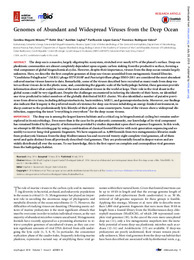Please use this identifier to cite or link to this item:
https://hdl.handle.net/11000/4841Full metadata record
| DC Field | Value | Language |
|---|---|---|
| dc.contributor.author | Megumi Mizuno, Carolina | - |
| dc.contributor.author | Ghai, Rohit | - |
| dc.contributor.author | Saghaï, Aurélien | - |
| dc.contributor.author | López García, Purificación | - |
| dc.contributor.author | Rodríguez Valera, Francisco | - |
| dc.contributor.other | Departamentos de la UMH::Producción Vegetal y Microbiología | es |
| dc.date.accessioned | 2018-10-01T07:44:14Z | - |
| dc.date.available | 2018-10-01T07:44:14Z | - |
| dc.date.created | 2016-06-19 | - |
| dc.date.issued | 2018-10-01 | - |
| dc.identifier.issn | 2150-7511 | - |
| dc.identifier.uri | http://hdl.handle.net/11000/4841 | - |
| dc.description.abstract | The deep sea is a massive, largely oligotrophic ecosystem, stretched over nearly 65% of the planet’s surface. Deep-sea planktonic communities are almost completely dependent upon organic carbon sinking from the productive surface, forming a vital component of global biogeochemical cycles. However, despite their importance, viruses from the deep ocean remain largely unknown. Here, we describe the first complete genomes of deep-sea viruses assembled from metagenomic fosmid libraries. “Candidatus Pelagibacter” (SAR11) phage HTVC010P and Puniceispirillum phage HMO-2011 are considered the most abundant cultured marine viruses known to date. Remarkably, some of the viruses described here recruited as many reads from deep waters as these viruses do in the photic zone, and, considering the gigantic scale of the bathypelagic habitat, these genomes provide information about what could be some of the most abundant viruses in the world at large. Their role in the viral shunt in the global ocean could be very significant. Despite the challenges encountered in inferring the identity of their hosts, we identified one virus predicted to infect members of the globally distributed SAR11 cluster. We also identified a number of putative proviruses from diverse taxa, including deltaproteobacteria, bacteroidetes, SAR11, and gammaproteobacteria. Moreover, our findings also indicate that lysogeny is the preferred mode of existence for deep-sea viruses inhabiting an energy-limited environment, in sharp contrast to the predominantly lytic lifestyle of their photic-zone counterparts. Some of the viruses show a widespread distribution, supporting the tenet “everything is everywhere” for the deep-ocean virome | es |
| dc.description.sponsorship | Work in FR-V laboratory was supported by projects MEDIMAX BFPU2013-48007-P from the Spanish Ministerio de Economía y Competitividad, | - |
| dc.description.sponsorship | MaCuMBA Project 311975 of the European Commission FP7 | - |
| dc.description.sponsorship | PROMETEO II/2014/012 project AQUAMET from the Generalitat Valenciana | - |
| dc.description.sponsorship | CMM was partially supported by an EMBO short-term fellowship | - |
| dc.description.sponsorship | RG was partially supported by the Grant Agency of the Czech Science Foundation under the research grant 13-00243S | - |
| dc.description.sponsorship | Work in PLG’s lab was funded by the French National Agency for Research (ANR-08-GENM-024-002) | - |
| dc.description.sponsorship | The European Research Council (ERC) under the European Commission 7th Framework Program (ERC Grant Agreement 322669). | - |
| dc.format | application/pdf | es |
| dc.format.extent | 9 | es |
| dc.language.iso | eng | es |
| dc.rights | info:eu-repo/semantics/openAccess | es |
| dc.subject.other | 579 - Microbiología | es |
| dc.title | Genomes of Abundant and Widespread Viruses from the Deep Ocean | es |
| dc.type | info:eu-repo/semantics/article | es |
| dc.identifier.doi | 10.1128 / mBio.00805-16 | - |
| dc.relation.publisherversion | https://doi.org/10.1128 / mBio.00805-16 | - |

View/Open:
Genomes of Abundant widespread viruses deep ocean.pdf
3,33 MB
Adobe PDF
Share:
.png)
